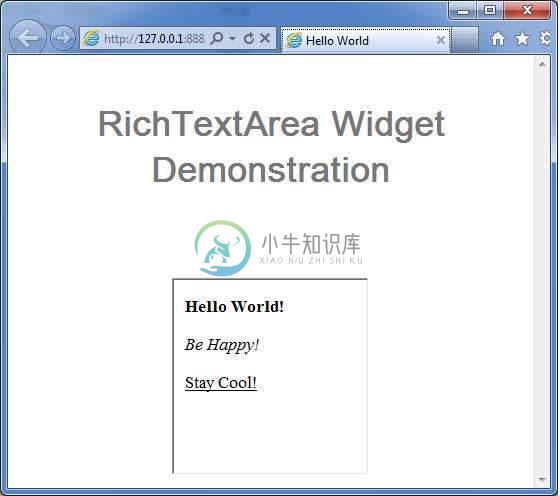RichTextArea
介绍 (Introduction)
RichTextArea小部件表示一个富文本编辑器,允许复杂的样式和格式。 由于某些浏览器不支持富文本编辑,而其他浏览器仅支持有限的功能子集,因此有两个格式化程序接口,可通过getBasicFormatter()和getExtendedFormatter()访问。
完全不支持富文本编辑的浏览器将为这两者返回null,而仅支持基本功能的浏览器将为后者getExtendedFormatter()返回null。
Class 声明 (Class Declaration)
以下是com.google.gwt.user.client.ui.RichTextArea类的声明 -
public class RichTextArea
extends FocusWidget
implements HasHTML, HasInitializeHandlers, HasSafeHtml
CSS样式规则 (CSS Style Rules)
以下默认CSS样式规则将应用于所有TextBox小部件。 您可以根据自己的要求覆盖它。
.gwt-RichTextArea {}
类构造函数 (Class Constructors)
| Sr.No. | 构造函数和描述 |
|---|---|
| 1 | RichTextArea() 创建一个没有样式表的新的空白RichTextArea对象。 |
Class Methods
| Sr.No. | 功能名称和描述 |
|---|---|
| 1 | HandlerRegistration addInitializeHandler(InitializeHandler handler) 添加InitializeEvent处理程序。 |
| 2 | RichTextArea.BasicFormatter getBasicFormatter() 已过时。 请改用getFormatter()。 |
| 3 | RichTextArea.ExtendedFormatter getExtendedFormatter() 已过时。 请改用getFormatter()。 |
| 4 | RichTextArea.Formatter getFormatter() 获取富文本格式化界面。 |
| 5 | java.lang.String getHTML() 以HTML格式获取此对象的内容。 |
| 6 | java.lang.String getText() 获取此对象的文本。 |
| 7 | boolean isEnabled() 获取是否启用此窗口小部件。 |
| 8 | protected void onAttach() 当窗口小部件附加到浏览器的文档时,将调用此方法。 |
| 9 | protected void onDetach() 当窗口小部件与浏览器的文档分离时,将调用此方法。 |
| 10 | void setEnabled(boolean enabled) 设置是否启用此窗口小部件。 |
| 11 | void setFocus(boolean focused) 明确关注/取消聚焦此小部件。 |
| 12 | void setHTML(java.lang.String safeHtml) 通过安全的HTML设置此对象的内容。 |
| 13 | void setHTML(java.lang.String html) 通过HTML设置此对象的内容。 |
| 14 | void setText(java.lang.String text) 设置此对象的文本。 |
方法继承 (Methods Inherited)
该类继承以下类中的方法 -
com.google.gwt.user.client.ui.UIObject
com.google.gwt.user.client.ui.Widget
com.google.gwt.user.client.ui.FocusWidget
java.lang.Object
RichTextBox小部件示例
此示例将指导您完成在GWT中显示RichTextBox Widget的使用的简单步骤。 按照以下步骤更新我们在GWT - Create Application的GWT应用程序GWT - Create Application章节 -
| 步 | 描述 |
|---|---|
| 1 | 在com.包下创建一个名为HelloWorld的项目,如GWT - Create Application一章中所述。 |
| 2 | 修改HelloWorld.gwt.xml , HelloWorld.css , HelloWorld.html和HelloWorld.java ,如下所述。 保持其余文件不变。 |
| 3 | 编译并运行应用程序以验证实现的逻辑的结果。 |
以下是修改后的模块描述符src/com.
/HelloWorld.gwt.xml 。<?xml version = "1.0" encoding = "UTF-8"?>
<module rename-to = 'helloworld'>
<!-- Inherit the core Web Toolkit stuff. -->
<inherits name = 'com.google.gwt.user.User'/>
<!-- Inherit the default GWT style sheet. -->
<inherits name = 'com.google.gwt.user.theme.clean.Clean'/>
<!-- Specify the app entry point class. -->
<entry-point class = 'com..client.HelloWorld'/>
<!-- Specify the paths for translatable code -->
<source path = 'client'/>
<source path = 'shared'/>
</module>
以下是修改后的样式表文件war/HelloWorld.css 。
body {
text-align: center;
font-family: verdana, sans-serif;
}
h1 {
font-size: 2em;
font-weight: bold;
color: #777777;
margin: 40px 0px 70px;
text-align: center;
}
.gwt-RichTextArea {
padding:10px;
}
以下是修改后的HTML主机文件war/HelloWorld.html 。
<html>
<head>
<title>Hello World</title>
<link rel = "stylesheet" href = "HelloWorld.css"/>
<script language = "javascript" src = "helloworld/helloworld.nocache.js">
</script>
</head>
<body>
<h1>RichTextArea Widget Demonstration</h1>
<div id = "gwtContainer"></div>
</body>
</html>
让我们有以下Java文件src/com.
/HelloWorld.java ,它将演示TextBox小部件的使用。package com..client;
import com.google.gwt.core.client.EntryPoint;
import com.google.gwt.user.client.ui.RichTextArea;
import com.google.gwt.user.client.ui.RootPanel;
import com.google.gwt.user.client.ui.VerticalPanel;
public class HelloWorld implements EntryPoint {
public void onModuleLoad() {
//create RichTextArea elements
RichTextArea richTextArea = new RichTextArea();
richTextArea.setHeight("200");
richTextArea.setWidth("200");
//add text to text area
richTextArea.setHTML("<b>Hello World!</b> <br/> <br/>" +
"<i>Be Happy!</i> </br> <br/> <u>Stay Cool!</u>");
// Add text boxes to the root panel.
VerticalPanel panel = new VerticalPanel();
panel.add(richTextArea);
RootPanel.get("gwtContainer").add(panel);
}
}
一旦准备好完成所有更改,让我们像在GWT - 创建应用程序章节中那样在开发模式下编译和运行应用程序 。 如果您的应用程序一切正常,这将产生以下结果 -


